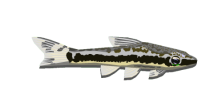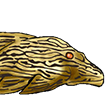| Scientific Name | Microglanis aff. iheringi |
| Common Names | South American Bumblebee Catfish Bambi Cat (Peru), Kleiner Marmor-Antennenwels, Kleiner Harlekinwels (Germany) |
| Pronunciation | aye herr ing ee |
| Etymology | Micro - small, glanis - catfish - in reference to the rather small forms of catfish that this genus contains. |
| Articles | |
| Size | 70mm or 2.8" SL. Find near, nearer or same sized spp. |
| Identification | The genus Microglanis was described by Eigenmann
(1912) to include small pimelodids with the head as wide as long, the skull covered by skin only; the occipital crest small; frontal fontanel not extending much if any behind the eye, and a minute occipital fontanel sometimes present; eye without a free orbital margin; dorsal and pectoral spines well developed; and premaxillary patches of teeth without backward projecting angles. The South American bumblebee catfish is so called because of its yellowish and black banding but to call it simply the bumblebee catfish would be misleading as the larger Asian Bagrid Pseudomystus siamensis is commonly referred to as THE bumblebee catfish. As a quirk of how the export markets change over the years you are now much more likely to encounter the South American for sale. M. aff. iheringi have a yellow or yellow-pink base color with a U-or V-shaped solid dark black or brown saddle beneath the dorsal fin. The base color may be clean (i.e., almost a pure color, not mottled or streaked) or streaked/mottled with a brown wood-grain marking over the base color. Some types also have a small pale spot in the center of the black/brown subdorsal saddle. The caudal fin varies from emarginate to slightly forked, with the lower lobe of the caudal fin being slightly larger and with more soft rays than the upper lobe. Coloration on the tail is highly variable, ranging from a solid black/brown vertical band to just two small broken dark bands on the separated upper and lower caudal fin lobes. |
| Sexing | Well-conditioned females are conspicuously wider in the abdomen than similarly sized males. |
| General Remarks | Real M. iheringi from the Turmero basin in Venezuela are essentially non-existent in the aquarium hobby. To our knowledge, all fish sold as M. iheringi in the hobby are M. aff. iheringi, collected along the Orinoco basin, mostly in Eastern Colombia, rather than from Northern Venezuela. The Orinoco fish represent at least three different species of Microglanis, all similar to M. iheringi in color pattern but each distinct in its own way. These species vary in size from 5cm to over 7cm maximum SL. |
| Distribution | South America: Orinoco river basin, including areas in Venezuela and Columbia. Orinoco (click on these areas to find other species found there) Orinoco, Lower Orinoco, Caura (click on these areas to find other species found there) Orinoco, Middle Orinoco, Meta (click on these areas to find other species found there) Orinoco, Middle Orinoco, Tomo (click on these areas to find other species found there) Orinoco, Middle Orinoco, Meta, Ocoa (click on these areas to find other species found there) Orinoco, Middle Orinoco, Meta, Metica, Guayuriba (click on these areas to find other species found there) Login to view the map. |
| IUCN Red List Category | Not Evaluated |
| pH | 6.0 - 7.5 |
| Temperature | 22.0-26.0°C or 71.6-78.8°F (Show species within this range) |
| Feeding | Omnivorous. This fish is not a fussy eater. Brineshrimp appears to be a special favourite. User data. |
| Furniture | Dense leafy vegetation such as provided by large clumps of Java fern or Amazon swords. Narrow cracks or holes in between rocks or wood are also used. |
| Compatibility | Non aggressive and sociable with its own and other species. |
| Suggested Tankmates | Virtually all good community fish, although any young fry present in the aquarium will be in extreme jeopardy - especially after dark. |
| Breeding | Egg scattering without any parental care. See Shane's World article. |
| Breeding Reports | There are 4 breeding reports, read them all here. |
| Reference | |
| Registered Keepers | There are 188 registered keepers, view all "my cats" data. |
| Wishlists | Love this species? Click the heart to add it to your wish list. There are 10 wishes to keep this species, see who wants what. |
| Spotters | Spotted this species somewhere? Click the binoculars! There are 40 records of this fish being seen, view them all. |
| Forum BBCode | |
| Search for M. aff. iheringi | |
| Look up M. aff. iheringi on AquaticRepublic.com | |
| LFS label creator ARN ref:1.31.106.303 | |
| Last Update | 2023 Jan 30 10:12 (species record created: 2001 Apr 22 00:00) |





/siluriformes/pseudopimelodidae/microglanis/aff_iheringi/1.jpg)
/siluriformes/pseudopimelodidae/microglanis/aff_iheringi/2.jpg)
/siluriformes/pseudopimelodidae/microglanis/aff_iheringi/3.jpg)

/siluriformes/pseudopimelodidae/microglanis/aff_iheringi/5.jpg)
/siluriformes/pseudopimelodidae/microglanis/aff_iheringi/6.jpg)
/siluriformes/pseudopimelodidae/microglanis/aff_iheringi/7.jpg)
/siluriformes/pseudopimelodidae/microglanis/aff_iheringi/8.jpg)
/siluriformes/pseudopimelodidae/microglanis/aff_iheringi/9.jpg)
/siluriformes/pseudopimelodidae/microglanis/aff_iheringi/10.jpg)
/siluriformes/pseudopimelodidae/microglanis/aff_iheringi/11.jpg)
/siluriformes/pseudopimelodidae/microglanis/aff_iheringi/12.jpg)
/siluriformes/pseudopimelodidae/microglanis/aff_iheringi/13.jpg)
/siluriformes/pseudopimelodidae/microglanis/aff_iheringi/14.jpg)
/siluriformes/pseudopimelodidae/microglanis/aff_iheringi/15.jpg)
/siluriformes/pseudopimelodidae/microglanis/aff_iheringi/16.jpg)
/siluriformes/pseudopimelodidae/microglanis/aff_iheringi/17.jpg)
/siluriformes/pseudopimelodidae/microglanis/aff_iheringi/18.jpg)
/siluriformes/pseudopimelodidae/microglanis/aff_iheringi/19.jpg)
/siluriformes/pseudopimelodidae/microglanis/aff_iheringi/20.jpg)
/siluriformes/pseudopimelodidae/microglanis/aff_iheringi/21.jpg)
/siluriformes/pseudopimelodidae/microglanis/aff_iheringi/22.jpg)
/siluriformes/pseudopimelodidae/microglanis/aff_iheringi/23.jpg)
/siluriformes/pseudopimelodidae/microglanis/aff_iheringi/24.jpg)
/siluriformes/pseudopimelodidae/microglanis/aff_iheringi/25.jpg)
/siluriformes/pseudopimelodidae/microglanis/aff_iheringi/26.jpg)
/siluriformes/pseudopimelodidae/microglanis/aff_iheringi/27.jpg)